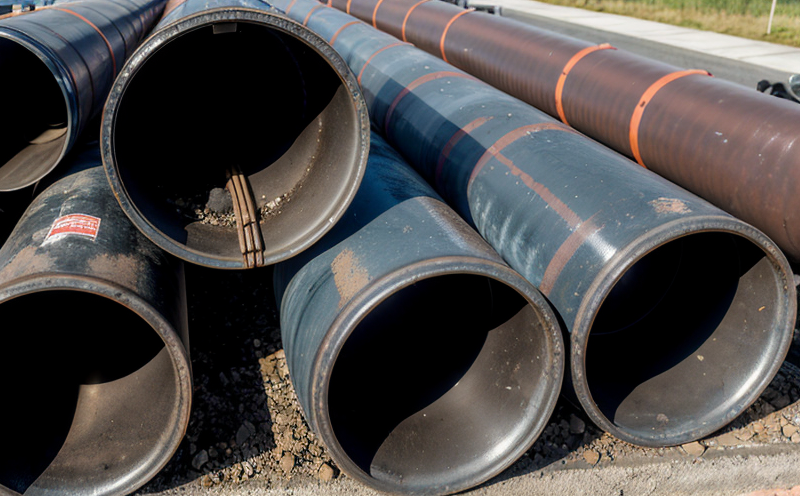JIS K 6739 Transparency Testing of Plastic Pipes
The JIS K 6739 test method is a critical procedure used to evaluate the transparency properties of plastic pipes. This standard specifies the measurement of light transmission through plastic pipes according to Japanese Industrial Standards (JIS). The test is essential for ensuring that plastic pipes meet specific transparency requirements, which are crucial in applications where clarity and visibility are important.
The testing process involves measuring the amount of visible light transmitted through a sample pipe. This measurement helps determine if the pipe meets the specified transparency grade as defined by JIS K 6739. The test is particularly relevant for pipes used in industries such as plumbing, irrigation, and medical applications where optical clarity can impact performance or safety.
The methodology for testing follows a standardized procedure laid out in JIS K 6739. It involves the use of specific equipment designed to accurately measure light transmission over a defined wavelength range. The test typically requires precise specimen preparation, ensuring that the sample is representative and free from defects that could affect the results.
The apparatus used for this testing includes a spectrophotometer capable of measuring light transmission at various wavelengths. The samples are cut to standard lengths and placed in a holder designed to minimize external interference with the measurement process. The test requires careful calibration of equipment and adherence to strict environmental conditions, such as temperature and humidity, to ensure accurate results.
The acceptance criteria for JIS K 6739 transparency testing are based on the light transmission values specified in the standard. Samples that do not meet these criteria may be rejected or require further processing before they can be used in applications where optical clarity is critical. This ensures that manufacturers produce pipes that meet the necessary quality standards and customer expectations.
- Customer Impact: Ensures that plastic pipes meet transparency requirements, enhancing customer satisfaction by delivering products that are visually clear and safe for intended use.
- Safety: Clear pipes allow for the visual inspection of contents, which is crucial in medical applications or when transporting hazardous materials.
- Quality Assurance: The test helps maintain consistent product quality across different batches and production runs.
The JIS K 6739 transparency test is a vital part of the quality control process in the manufacturing of plastic pipes. It ensures that products meet stringent industry standards, thereby enhancing reliability and trustworthiness in the market. By adhering to this testing protocol, manufacturers can ensure their products are safe, reliable, and meet customer expectations.
Why Choose This Test
Selecting JIS K 6739 transparency testing is a strategic choice for any manufacturer of plastic pipes. This test ensures that the products you produce meet international standards, which enhances their reputation and marketability. By choosing this service, you can:
- Ensure compliance with Japanese Industrial Standards.
- Demonstrate commitment to quality and reliability.
- Avoid non-compliance issues that could lead to product recalls or legal disputes.
- Enhance customer trust by delivering products that meet specific transparency requirements.
The JIS K 6739 test is particularly beneficial for manufacturers aiming to enter the Japanese market or those looking to gain a competitive edge in their industry. It provides a robust framework for quality assurance, ensuring that your products are not only safe but also meet the highest standards of transparency.
Quality and Reliability Assurance
The JIS K 6739 transparency test plays a crucial role in maintaining high-quality standards for plastic pipes. By adhering to this testing protocol, manufacturers can ensure that their products consistently meet the required transparency levels as defined by the standard. This commitment to quality not only enhances product reliability but also builds trust with customers and partners.
The process of JIS K 6739 ensures that every batch of plastic pipes produced is tested for transparency, providing a level of assurance that cannot be matched by other methods. This consistency in testing helps manufacturers identify any issues early on, allowing for corrective actions to be taken promptly. The result is a product that is not only reliable but also meets the specific requirements set by industry standards.
The test's rigorous nature ensures that only products meeting the specified criteria are released into the market. This commitment to quality control helps manufacturers avoid potential issues down the line, such as customer complaints or returns due to non-compliance with transparency requirements. By investing in JIS K 6739 testing, manufacturers demonstrate a dedication to excellence and reliability.
Customer Impact and Satisfaction
- Better Customer Trust: Clear pipes enhance customer trust by allowing visual inspection of contents, which is crucial in medical or hazardous material applications.
- Increased Sales: Meeting transparency requirements can lead to increased sales and market share in the Japanese market.
- Positive Reputation: Consistent adherence to JIS K 6739 testing protocols enhances a company's reputation for quality and reliability.
The impact of this test on customers is profound. By ensuring that plastic pipes meet the specified transparency requirements, manufacturers can enhance customer trust and satisfaction. This is particularly important in applications where optical clarity is critical, such as medical equipment or irrigation systems. Meeting these standards not only ensures product quality but also enhances the overall user experience.
The positive reputation gained from adhering to JIS K 6739 testing protocols can lead to increased sales and market share in competitive markets. Customers are more likely to choose products that meet stringent international standards, which can translate into higher customer satisfaction and loyalty.





